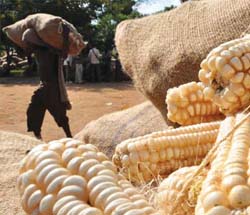Post-Harvest Losses: A Key Contributor to Food Insecurity in Kenya
By Kevin Onyango and Lilian Kirimi
- The national maize post-harvest losses are estimated to be between 12 and 20 percent of the total national production. At a 5-year national average production of 40 million 90-kg bags, the loss is between 4.8 and 8 million bags annually.
- The estimated national monthly consumption of maize is 3.39 million bags. Kenya, therefore, loses an equivalent of over 1 month of consumption or an equivalent of a whole short rains harvest, estimated at an average of 5 million bags.
- Strategies to reduce the losses such as promotion and investment in better post-harvest produce handling and management practices as well as appropriate and efficient on-farm and off-farm storage technologies are urgently required.
 In the face of serious food shortages been experienced, Kenya’s food security continues to be a major concern to policy makers and the entire citizenry. Key questions on how Kenya can transition permanently to a food self-sufficient state continue to be asked by all stakeholders.
In the face of serious food shortages been experienced, Kenya’s food security continues to be a major concern to policy makers and the entire citizenry. Key questions on how Kenya can transition permanently to a food self-sufficient state continue to be asked by all stakeholders.
Ironically, over 50 years after independence and with a number of legislations, policies and strategies, Kenya is still a food deficit country. However it is encouraging to note that in the recent past, the government has prioritised food security; currently food security is among the top four priorities to be addressed over the coming years.
Maize remains the main staple crop for the country with a 5 year average production of 40 million bags against an estimated demand of 45–50 million bags annually. Maize consumption (food use only) is estimated at 3.39 million bags per month or 40.7 million bags per year. This means that if all the maize produced went to food use, the country would still need to import around 1 million bags to meet the maize demand for food. This is further complicated given the need for maize for other uses including industrial manufacturing, seed and animal feed, which account for 2, 1 and 2 percent respectively.
Post-harvest losses are estimated at 12 – 20 percent of the total national production. The losses mainly include spillages during handling, transportation, processing and marketing; rotting and aflatoxin contamination due to improper handling and inadequate/inappropriate storage technologies; losses to pests such as birds, insects and rodents; and, mechanical damages during farm level elementary processing and off-farm value addition. Together, these account for a loss of between 4.8 and 8 million bags annually. This loss would be enough to cover 1.4 months of consumption demand for the country.
Climate variability and change has also emerged strongly as a contributor to post-harvest losses. The changing climatic patterns have altered the maize harvesting period conditions in most parts of Kenya’s grain basket with harvesting coinciding with rains or humid conditions in October-November-December. These conditions not only hinder proper grain drying but also provide conducive conditions for grain pests and disease build-up. Farmers without proper storage facilities (majority of smallholders) suffer huge losses as their produce is either rained on, lost to rot or severely infested by pests and diseases. This is part of the reason why farmers sell their produce immediately after harvest when prices are rock bottom.
Post-harvest losses are a major contributor to food inadequacy and must, therefore, be effectively addressed as a strategy to achieve the much desired state of food security. Use of several strategies and technologies along the value chain can be regarded as low-hanging fruits towards efforts to improve maize supply in the country.
 Simple and practical technologies and innovations exist, which need to be disseminated and scaled up to minimize losses. For instance, at the farm level, farmers can reduce their losses through proper practices such as timely harvesting, proper drying, maintenance of storage hygiene, grain treatment and employment of better processing and transportation techniques. Use of metal/plastic silos and hermetic bags has been shown to significantly reduce losses from pests.
Simple and practical technologies and innovations exist, which need to be disseminated and scaled up to minimize losses. For instance, at the farm level, farmers can reduce their losses through proper practices such as timely harvesting, proper drying, maintenance of storage hygiene, grain treatment and employment of better processing and transportation techniques. Use of metal/plastic silos and hermetic bags has been shown to significantly reduce losses from pests.
Both the national and county governments need to also ensure better transport infrastructure; promote good on-farm and off-farm produce handling and management practices through extension service provision and warehouse receipt initiatives; promotion of use of effective storage and processing facilities to ensure minimal losses such as well calibrated and operational driers; and ensuring proper pest and disease control mechanisms in the production and marketing systems.
Appropriate policies to address maize market imperfections and risks associated with climate change and variability, including price uncertainty will also aid in creating right incentives that will promote provision and accessibility to affordable and scalable solutions to the problem of post-harvest losses.